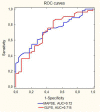Assessment of left ventricle function in aortic stenosis: mitral annular plane systolic excursion is not inferior to speckle tracking echocardiography derived global longitudinal peak strain
- PMID: 24373119
- PMCID: PMC3878794
- DOI: 10.1186/1476-7120-11-45
Assessment of left ventricle function in aortic stenosis: mitral annular plane systolic excursion is not inferior to speckle tracking echocardiography derived global longitudinal peak strain
Abstract
Background: Early detection of left ventricle (LV) systolic dysfunction is essential for management of patients with aortic stenosis (AS). Two- dimensional speckle tracking derived global longitudinal peak strain (GLPS) is more sensitive than ejection fraction (EF) but requires good image quality and is not easily accessible. The aim of the study was to compare GLPS with traditional echocardiographic parameter- mitral annular plane systolic excursion (MAPSE) in AS.
Material and methods: In consecutive patients with moderate to severe AS and LV ejection fraction ≥ 50% standard echocardiography and two-dimensional speckle tracking echocardiography were performed. Mitral annular plane systolic excursion and global longitudinal peak strain were obtained from apical echocardiographic views.
Results: A total of 82 patients were examined, median age was 68 (60-78), 56% of them were men. There was a positive correlation between aortic valve area index (AVAI) and: MAPSE (r = 0.334, p = 0.002), MAPSE indexed for body surface area- MAPSEI (r = 0.349, p = 0.001) and GLPS (r = 0.342, p = 0.002) but not EF (r = 0.031, p = 0.782). A positive correlation was found between GLPS and MAPSE (r = 0.558, p < 0.001) and between GLPS and MAPSEI (r = 0.543, p < 0.001). All above parameters were significantly lower in symptomatic patients compared to asymptomatic subjects (GLPS: -13.82 ± 3.56 vs. -16.39 ± 3.16%, p = 0.002, MAPSE: 10.49 ± 1.91 vs. 11.95 ± 1.82 mm, p = 0.001 and MAPSEI: 5.66 (4.83-6.6) vs. 6.46 ± 0.97 mm/m2, p = 0.005).
Conclusion: Despite the development of the modern echocardiographic techniques, mitral annular plane systolic excursion can still be used as a sensitive tool to detect early longitudinal LV systolic dysfunction.
Figures





Similar articles
-
Tissue Velocities and Myocardial Deformation in Asymptomatic and Symptomatic Aortic Stenosis.J Am Soc Echocardiogr. 2015 Aug;28(8):969-80. doi: 10.1016/j.echo.2015.03.013. Epub 2015 May 2. J Am Soc Echocardiogr. 2015. PMID: 25944424
-
Mitral Annular Plane Systolic Excursion-Derived Ejection Fraction: A Simple and Valid Tool in Adult Males With Left Ventricular Systolic Dysfunction.Echocardiography. 2016 Feb;33(2):179-84. doi: 10.1111/echo.13009. Epub 2015 Jul 14. Echocardiography. 2016. PMID: 26178447
-
Evaluation of right ventricular systolic function after mitral valve repair: a two-dimensional Doppler, speckle-tracking, and three-dimensional echocardiographic study.J Am Soc Echocardiogr. 2012 Jul;25(7):701-8. doi: 10.1016/j.echo.2012.03.017. Epub 2012 Apr 25. J Am Soc Echocardiogr. 2012. PMID: 22542273 Clinical Trial.
-
Clinical implication of mitral annular plane systolic excursion for patients with cardiovascular disease.Eur Heart J Cardiovasc Imaging. 2013 Mar;14(3):205-12. doi: 10.1093/ehjci/jes240. Epub 2012 Nov 15. Eur Heart J Cardiovasc Imaging. 2013. PMID: 23161791 Review.
-
Echocardiographic assessment of left ventricular mechanics in individuals with mitral valve prolapse: a systematic review and meta-analysis.Int J Cardiovasc Imaging. 2024 Aug;40(8):1617-1629. doi: 10.1007/s10554-024-03179-8. Epub 2024 Jul 8. Int J Cardiovasc Imaging. 2024. PMID: 38976111
Cited by
-
The strain and strain rate imaging paradox in echocardiography: overabundant literature in the last two decades but still uncertain clinical utility in an individual case.Arch Med Sci Atheroscler Dis. 2020 Dec 26;5:e297-e305. doi: 10.5114/amsad.2020.103032. eCollection 2020. Arch Med Sci Atheroscler Dis. 2020. PMID: 33644489 Free PMC article.
-
Z-score of Mitral Annular Plane Systolic Excursion is a Useful Indicator of Evaluation of Left Ventricular Function in Patients with Acute-Phase Kawasaki Disease.Pediatr Cardiol. 2017 Jun;38(5):1057-1064. doi: 10.1007/s00246-017-1619-4. Epub 2017 Apr 29. Pediatr Cardiol. 2017. PMID: 28456832
-
Echocardiographic Longitudinal Strain Analysis in Heart Failure: Real Usefulness for Clinical Management Beyond Diagnostic Value and Prognostic Correlations? A Comprehensive Review.Curr Heart Fail Rep. 2021 Oct;18(5):290-303. doi: 10.1007/s11897-021-00530-1. Epub 2021 Aug 16. Curr Heart Fail Rep. 2021. PMID: 34398411 Review.
-
Longitudinal wall fractional shortening: an M-mode index based on mitral annular plane systolic excursion (MAPSE) that correlates and predicts left ventricular longitudinal strain (LVLS) in intensive care patients.Crit Care. 2017 Nov 25;21(1):292. doi: 10.1186/s13054-017-1876-x. Crit Care. 2017. PMID: 29178915 Free PMC article.
-
Assessment of global longitudinal strain using standardized myocardial deformation imaging: a modality independent software approach.Clin Res Cardiol. 2015 Jul;104(7):591-602. doi: 10.1007/s00392-015-0822-7. Epub 2015 Feb 3. Clin Res Cardiol. 2015. PMID: 25643953
References
-
- Iung B, Baron G, Butchart EG, Delahaye F, Gohlke-Bärwolf C, Levang OW, Tornos P, Vanoverschelde JL, Vermeer F, Boersma E, Ravaud P, Vahanian A. A prospective survey of patients with valvular heart disease in Europe: the euro heart survey on valvular heart disease. Eur Heart J. 2003;11:1231–1243. doi: 10.1016/S0195-668X(03)00201-X. - DOI - PubMed
-
- Vahanian A, Alfieri O, Andreotti F, Antunes MJ, Baron-Esquivias G, Baumgartner H, Borger MA, Carrel TP, De Bonis M, Evangelista A, Falk V, Iung B, Lancellotti P, Pierard L, Price S, Schafers HJ, Schuler G, Stepinska J, Swedberg K, Takkenberg J, Von Oppell UO, Windecker S, Zamorano JL, Zembala M. Guidelines on the management of valvular heart disease (version 2012). Joint Task Force on the Management of Valvular Heart Disease of the European Society of Cardiology (ESC); European Association for Cardio-Thoracic Surgery (EACTS) Eur Heart J. 2012;11:2451–2496. - PubMed
-
- Miyazaki S, Daimon M, Miyazaki T, Onishi Y, Koiso Y, Nishizaki Y, Ichikawa R, Chiang SJ, Makinae H, Suzuki H, Daida H. Global longitudinal strain in relation to the severity of aortic stenosis: a two-dimensional speckle-tracking study. Echocardiography. 2011;11:703–708. doi: 10.1111/j.1540-8175.2011.01419.x. - DOI - PubMed
Publication types
MeSH terms
LinkOut - more resources
Full Text Sources
Other Literature Sources
Research Materials

